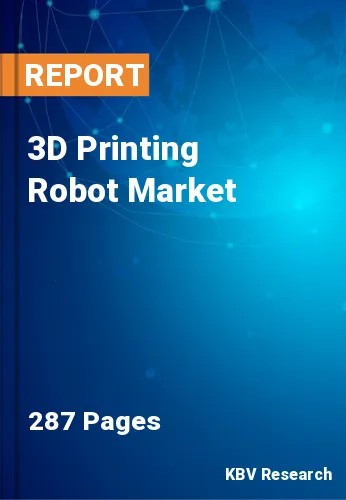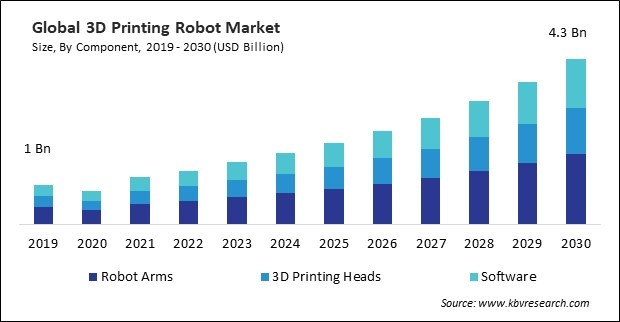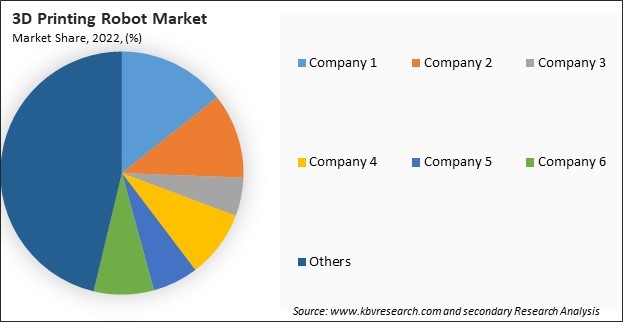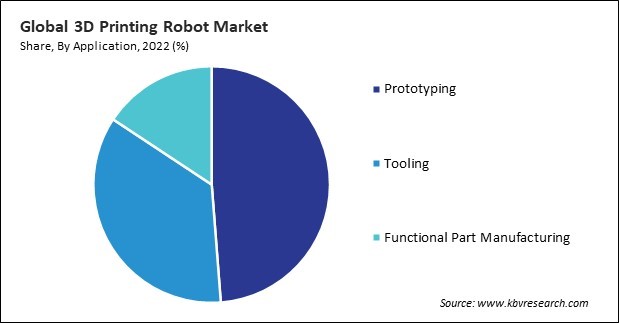
The Global 3D Printing Robot Market size is expected to reach $4.3 billion by 2030, rising at a market growth of 14.8% CAGR during the forecast period.
The utilization of metal 3D printing, specifically with titanium and aluminum alloys, is indispensable in the aerospace sector. It enables the fabrication of complex, lightweight components with exceptional strength and durability. This feature offers notable benefits in the aerospace industry, specifically regarding aircraft weight reduction and improved fuel efficiency. Consequently, the Aerospace & Defense segment would acquire nearly 25% of the total market share by 2030. Composite materials, manufactured by fusing distinct materials to attain desired properties, find application in the aerospace sector. Through the utilization of composite materials, 3D printing facilitates the fabrication of complex structures that are both lightweight and durable.

These robots have revolutionized the healthcare industry by enabling the production of custom implants and prosthetics tailored to the unique anatomy of patients. This level of customization ensures a better fit, reducing the risk of complications and improving patient outcomes. Furthermore, companies leveraging these robots to offer personalized products can differentiate themselves in the market. This uniqueness often attracts customers seeking tailored solutions and experiences. Thus, these factors will help expand the market. Additionally, traditional manufacturing processes often involve subtractive methods, where raw materials are cut or shaped into the final product. This can result in significant material wastage, as excess material is removed during production. In contrast, 3D printing is classified as an additive manufacturing technique. It constructs objects by applying material only in the proportions required for the end result. This reduces material wastage, making the production process more resource efficient. Additionally, prototyping is a crucial phase in product development, where multiple design iterations are created and tested before finalizing the product. Rapid prototyping is made possible through 3D printing, which enables the economical and timely creation of prototypes. Hence, these aspects will increase demand in the market.
However, acquiring 3D printing equipment, such as high-quality printers and associated hardware, can require a substantial upfront investment. The cost of advanced 3D printers with multiple functionalities, high precision, and large printing volumes can be a barrier for smaller businesses. Moreover, regular maintenance of 3D printing equipment is essential to ensure consistent performance. Costs associated with maintenance, repairs, and the need for skilled technicians can add to the overall operational expenses. Owing to these factors, there will be reduced demand for these robots.

The leading players in the market are competing with diverse innovative offerings to remain competitive in the market. The above illustration shows the percentage of revenue shared by some of the leading companies in the market. The leading players of the market are adopting various strategies in order to cater demand coming from the different industries. The key developmental strategies in the market are Acquisitions, and Partnerships & Collaborations.
 Drivers
Drivers  Restraints
Restraints  Opportunities
Opportunities  Challenges
Challenges Based on component, the market is segmented into robot arms, 3D printing heads, and software. In 2022, the 3D printing heads segment garnered a significant revenue share in the market. The demand for 3D printers capable of handling multiple materials simultaneously has fueled the growth of the 3D printing heads segment. By enabling the production of complex, functional objects with diverse properties, multi-material printing broadens the scope of its applications in the healthcare, automotive, and electronics sectors. Therefore, the segment will expand rapidly in the coming years.
Based on application, the market is divided into prototyping, tooling, and functional part manufacturing. In 2022, the tooling segment witnessed a substantial revenue share in the market. The intricate and complex geometries produced by 3D printing are difficult, if not impossible, to attain through conventional manufacturing techniques. This translates to the ability to design lightweight yet structurally robust tools in tooling. In particular, the automotive and aerospace industries benefit from lightweight tooling, contributing to improved efficiency and reduced operational strain. Owing to these aspects, the segment will witness increased demand in the coming years.

On the basis of robot type, the market is divided into articulated robots, cartesian robots, scara robots, polar robots, delta robots, and others. In 2022, the cartesian robots segment witnessed a substantial revenue share in the market. Cartesian robots are generally considered more straightforward in design and operation than robotic systems. This simplicity contributes to their accessibility, making Cartesian robots attractive to a broader range of users, including small and medium-sized enterprises (SMEs) that may not have extensive expertise in complex robotic systems. These aspects will pose lucrative growth prospects for the segment.
On the basis of end user, the market is divided into automotive, FMCG, aerospace & defense, construction, culinary, and others. In 2022, the automotive segment witnessed a substantial revenue share in the market. By utilizing 3D printing for rapid prototyping, automotive manufacturers can bring new vehicle designs to market more efficiently. Rapid prototyping enables expedited design validation, diminishing the time and financial investments of conventional prototyping techniques. Owing to these aspects, the segment will expand rapidly in the upcoming years.
Free Valuable Insights: Global 3D Printing Robot Market size to reach USD 4.3 Billion by 2030
By region, the market is segmented into North America, Europe, Asia Pacific, and LAMEA. The North America segment procured the highest revenue share in the market in 2022. There has been an increasing need for 3D printing technologies in the region, evident in numerous sectors such as aerospace, healthcare, automotive, and manufacturing. The robust technological infrastructure, coupled with a high level of industrialization, has propelled the adoption of these robots in North America. Thus, these factors will pose lucrative growth prospects for the segment.
| Report Attribute | Details |
|---|---|
| Market size value in 2022 | USD 1.4 Billion |
| Market size forecast in 2030 | USD 4.3 Billion |
| Base Year | 2022 |
| Historical Period | 2019 to 2021 |
| Forecast Period | 2023 to 2030 |
| Revenue Growth Rate | CAGR of 14.8% from 2023 to 2030 |
| Number of Pages | 287 |
| Number of Tables | 500 |
| Report coverage | Market Trends, Revenue Estimation and Forecast, Segmentation Analysis, Regional and Country Breakdown, Market Share Analysis, Porter’s 5 Forces Analysis, Company Profiling, Companies Strategic Developments, SWOT Analysis, Winning Imperatives |
| Segments covered | Component, Application, Robot Type, End User, Region |
| Country scope |
|
| Companies Included | Kuka AG (Midea Group Co., Ltd.), ABB Group, Yaskawa Electric Corporation , FANUC Corporation, Universal Robots A/S (Teradyne, Inc.), Massive Dimension, CEAD B.V. , Caracol, Meltio3D and Comau S.p.A. (Stellantis N.V.) |
By Component
By Application
By Robot Type
By End User
By Geography
The Market size is projected to reach USD $4.3 billion by 2030.
Increased usage of innovative materials are driving the Market in coming years, however, High costs associated with 3D printing technology restraints the growth of the Market.
Kuka AG (Midea Group Co., Ltd.), ABB Group, Yaskawa Electric Corporation , FANUC Corporation, Universal Robots A/S (Teradyne, Inc.), Massive Dimension, CEAD B.V. , Caracol, Meltio3D and Comau S.p.A. (Stellantis N.V.)
The Robot Arms segment is generating the highest revenue in the Market by Component in 2022; thereby, achieving a market value of $1.8 billion by 2030.
The North America region dominated the Market by Region in 2022, and would continue to be a dominant market till 2030; thereby, achieving a market value of $1.5 billion by 2030.
Our team of dedicated experts can provide you with attractive expansion opportunities for your business.
